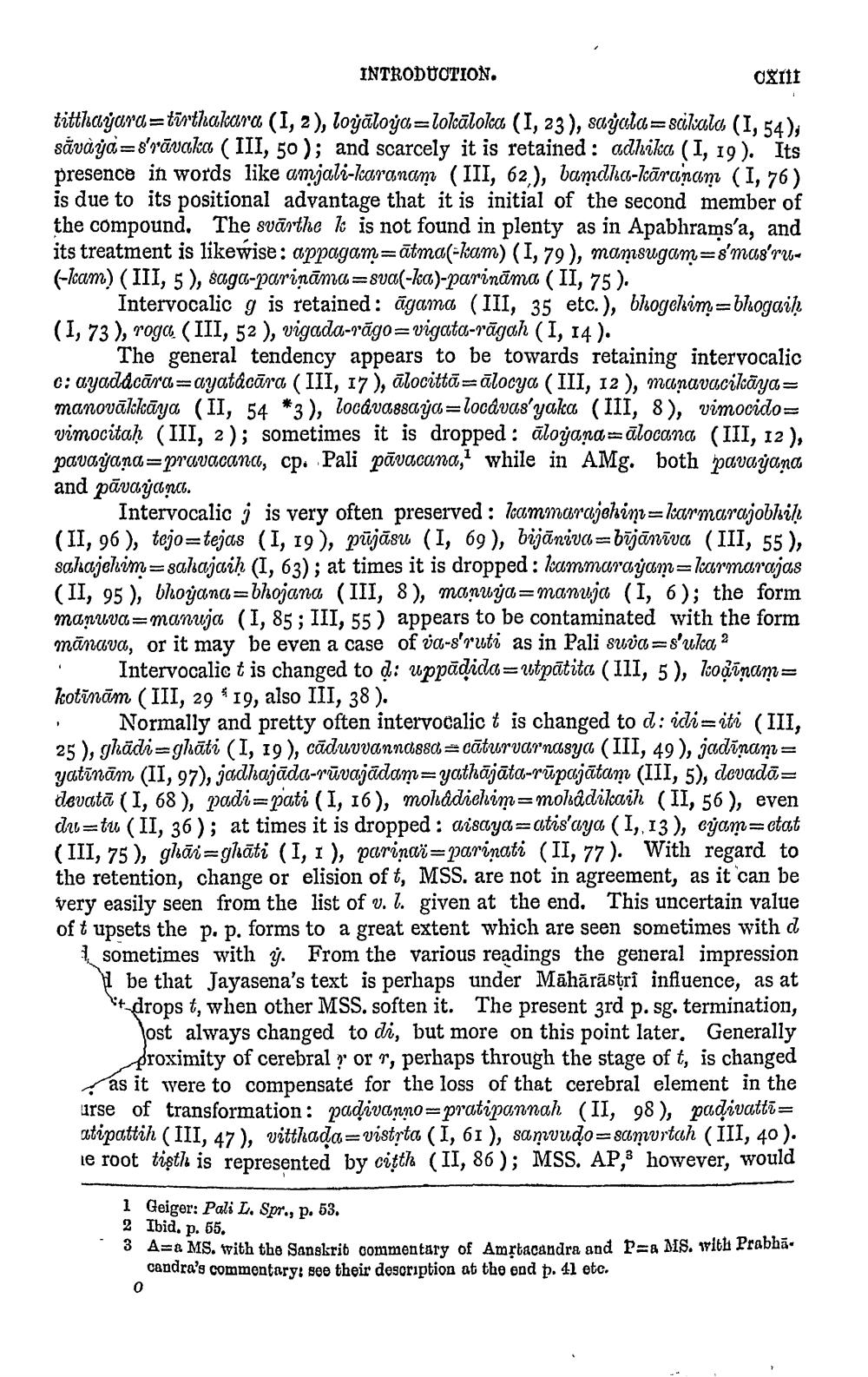________________
INTRODUCTION.
OXIII
titthayard=tūrthakara (1, 2), lojāloya=lolcālolca (I, 23), sayala=scikala (1, 54), săvàýd=s'rāvaka ( III, 50 ); and scarcely it is retained : adhika (I, 19). Its presence in words like amjali-karanam (III, 62), bandhc-lcāranan (I, 76) is due to its positional advantage that it is initial of the second the compound. The svārthe K is not found in plenty as in Apabhrams'a, and its treatment is likewise: appagam=ātma(-kam) (1,79 ), mamsugam=s'mus'ru(-lam) (III, 5), saga-parināma=sva(-ka)-parināma (II, 75).
Intervocalic g is retained: āgama (III, 35 etc.), bhogelim=blogaih (1,73 ), roga (III, 52 ), vigada-rāgo=vigata-rāgah (I, 14).
The general tendency appears to be towards retaining intervocalic c: ayaddcāra=ayatácāra (III, 17), ālocittā=ālocya (III, 12 ), manavacilāyamanovākkāya (II, 54 *3), locavassaya=locavas'yaka (III, 8), vimocido vimocitaḥ (III, 2); sometimes it is dropped : āloyana =ālocana (III, 12 ), pavayana=pravacanco, cp. Pali pāvacana,' while in AMg. both pavayana and pāvajandi.
Intervocalic j is very often preserved : Icammarajehin=karmarajobhiḥ (II, 96 ), tejo=tejas (I, 19), pūjāsu (I, 69), bijāniva=bījānīva (III, 55), sahajenim=sahajaih (I, 63); at times it is dropped : kammarayam=larmarajas (II, 95), bloyana=bhojana (III, 8), manwyd=manuja (1, 6); the form manuva=manuja (1, 85; III, 55 ) appears to be contaminated with the form mõnava, or it may be even a case of va-s'ruti as in Pali suva=s'ulca 2
Intervocalic t is changed to d: uppādida=utpatito (III, 5), kođīnum= kotīnām (III, 2919, also III, 38).
Normally and pretty often intervocalic † is changed to d: idi=iti (III, 25 ), grādi=glāti (I, 19), căduvvannassd=cāturvarnasya (III, 49 ), jadīnaņ= yatīnām (II, 97), jadrajāda-rūvajādam=yathājāta-rūpajātam (III, 5), cevadā= devatā (I, 68), padi=pati (1, 16), moliddiehim=molddilaih (II, 56), even dre=tu (II, 36); at times it is dropped: aisaya=atis'aya (I,,13), cyam=ctat (III, 75), ghāi=glāti (1, 1), parinai=parinati (II, 77). With regard to the retention, change or elision of t, MSS. are not in agreement, as it can be very easily seen from the list of v. l. given at the end. This uncertain value of t upsets the p. p. forms to a great extent which are seen sometimes with d
sometimes with ý. From the various readings the general impression
be that Jayasena's text is perhaps under Māhārāstri influence, as at *_drops t, when other MSS. soften it. The present 3rd p. sg. termination,
Jost always changed to di, but more on this point later. Generally
proximity of cerebral ? or ?, perhaps through the stage of t, is changed as it were to compensate for the loss of that cerebral element in the urse of transformation : padivanno-pratipannah (II, 98), padivattī= atipattih (III, 47), vitthada=vistyta (I, 61), sanvudo=sanvrtah (III, 40 ). le root tişth is represented by citth (II, 86); MSS. AP, however, would
1 Geiger: Pali L. Spr., p. 53. 2 Ibid. p. 55.
A=a MS. with the Sanskrit commentary of Amrtacandra and P=& MS. With Prar candra's commentary: see their description at the end p. 41 etc.




